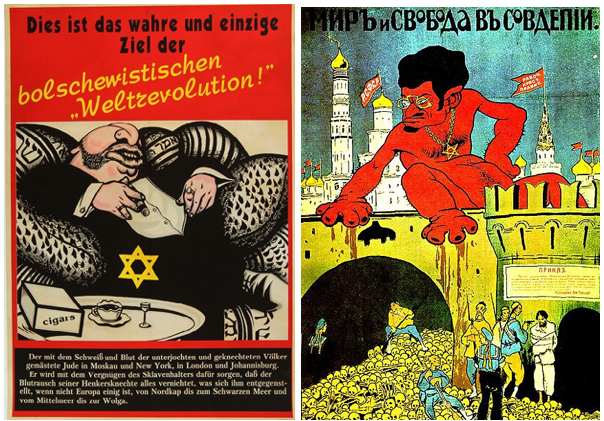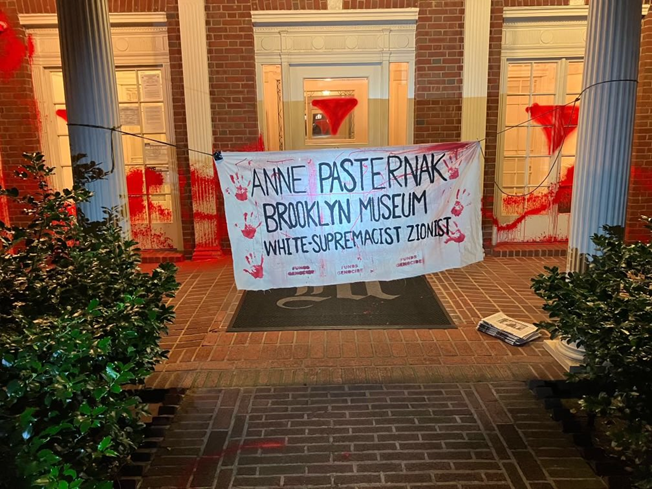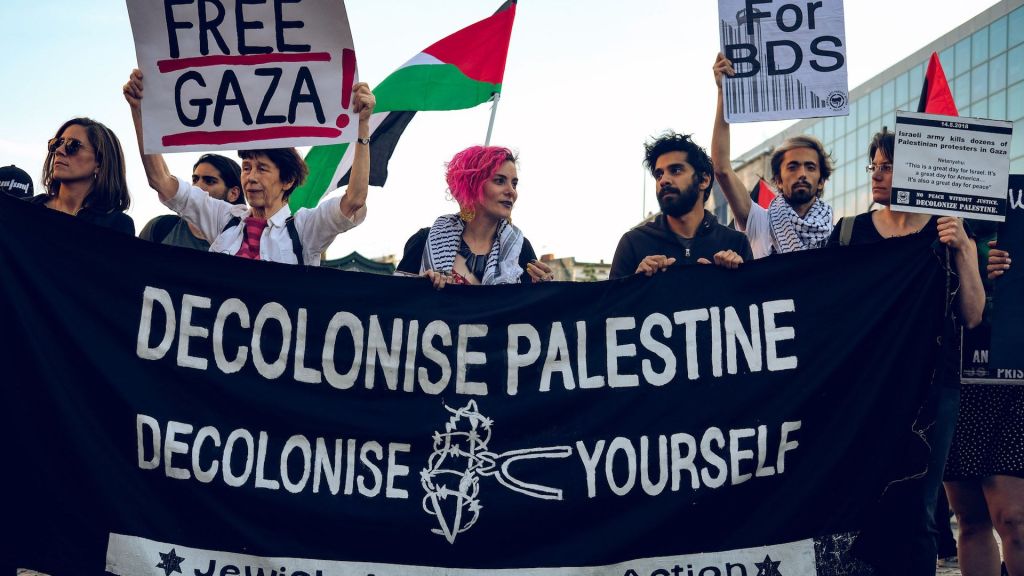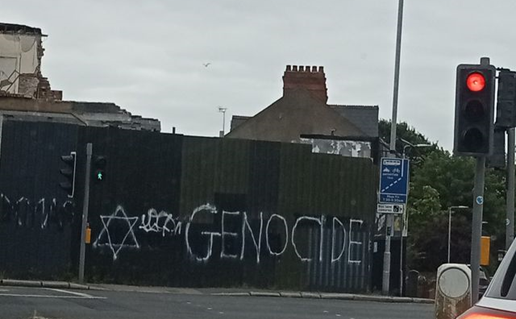A scene from one of the many online videos of the Gaza-related university campus occupations sticks in my mind. A Jewish student attempting to get to class is confronted by a group of ‘occupiers’. “Are you a Zionist?” they ask him. “Of course I’m a Zionist”, he answers, and so they physically block him from entering the campus without another word, their smug conceit barely concealed by the keffiyehs that mask their identity. It was a small incident, involving a dozen individuals at most, but as a demonstration of anti-Semitism in the guise of anti-Zionism, I thought it could not be beaten.
But then this video appeared in recent days, of ‘protestors’ on the New York subway. “Raise your hand if you’re a Zionist! This is your chance to get out!” they demand. This incident was bigger and more menacing; the intent to drive out Jews from ordinary public life more explicit.
I have friends, people of political experience and discernment, who deny the evidence of their own eyes. Who minimise or dismiss such actions as the craziness of fringe elements, unconnected with the occupations or wider protests around Palestine. Who are gripped by a seemingly inexplicable lethargy when confronted with these actions, look away, cover their ears to silence the clanging of warning bells. And the longer they turn away, the more difficult it becomes for them to face the threat.

To my friends who were outraged and offended by my assertion that the supposedly ‘pro-Palestine’ marches around the world were led by Hamas supporters, to those who have claimed they were unaware of any Hamas supporters marching beside them: I offer these photos of the group of drummers leading a recent ‘pro-Palestine’ march in Australia. The location is fixed by the church in the background, the CrossCulture Church of Christ on Swanston Street, Melbourne. The drummers are wearing a badge with the Hamas emblem. Several in the following rows are carrying the jihadist white-on-black flag used by Islamic State. One wears a sweatshirt with the anti-Semitic chant: ”Khaybar Khaybar Ya Yahud, Jaish Muhammad soufa yaʿoud.” It refers to a massacre of a tribe of Jews in early Islamic history, and translates roughly as ”Khaybar, Khaybar, Oh Jews! The army of Muhammad will return!”
I ask these friends: would you join a march behind these banners?

One friend has compared the Hamas atrocities of 7 October with the killing by Te Kooti of 60 people at Matawhero – both European settlers and their Māori neighbours – in 1868 New Zealand. Others have compared it with the violence and killings of the early slave revolts led by Nat Turner and others in the United States in the lead-up to the Civil War.
I ask these friends: did you show the same fond indulgence toward the Islamists of Boko Haram when they abducted and raped hundreds of Nigerian schoolgirls, ‘marrying’ them to their abductors, and killed thousands? Or to Islamic State, when they carried out the grisly beheadings, tortures, mutilations, when they threw people down wells, in their rampage across Iraq and Syria? Were those actions also comparable to Nat Turner’s slave revolt or Te Kooti’s vengeance? Are they not equally justified by the decades of impoverishment of the Muslim regions of the Nigerian Sahel, and discrimination against Sunni Muslims by the US-sponsored regime in Baghdad? Are not the Nigerian, Iraqi and Syrian regimes tools of imperialism? Or… is there a double standard at work here?

To those friends who in recent weeks have been turning their efforts to explaining that criticism of the Israeli state anti-Zionism is not anti-Semitism, I say: you’re simply missing the point. Of course it is true that not all criticism of Israel is anti-Semitic, that anti-Zionism is not necessarily anti-Semitism, it is not always anti-Semitism. But sometimes, nonetheless… it is. And when anti-Semitism is what it is, this fact needs to be stated, and the dangers recognised.
Pogroms were never launched against Jews simply because they were Jews. Look at the terrible history of the pogroms in Russia, Poland and Ukraine in the late nineteenth and early twentieth centuries, look at how the Nazis used anti-Semitism in their propaganda: it was always because the Jews were fat cat bankers or bloodthirsty Bolsheviks1, arch-manipulators or filthy immigrants, or cheating shopkeepers, or because they controlled the media, or because they murdered Christian babies for their religious rites, or because they fought back, or because they didn’t fight back – but never just because they were Jews.

And today, the pretext is because they are Zionists. Take for example the protest outside a New York exhibition honouring the memories of the hundreds of people killed at the Nova Music Festival on October 7. The protest sought to justify and support that massacre of innocent young people. One participant carries a placard – the only placard on display, as far as I can see – that reads “Zionists are not Jews & not human.” [my emphasis]. Or look at the vandalism at the home of the director of the Brooklyn museum: The inverted red triangle and bloody handprint is the symbol of the modern anti-Semites, their threat of violence bundled together with a deep sense of their own righteousness, their swastika, their burning cross.
The campus occupations at least had the merit of clarifying one thing: that the universities are at the centre of the new resurgence of Jew-hatred. Who would have guessed, a few years back, that of all the institutions of capitalist society in its phase of decay, the universities would be among the first to exhibit such clear evidence of putrefaction?

The decolonisation narrative which has dominated academic discourse for many years has played a major part in preparing these events politically.
Decolonisation was once the slogan of a political struggle. In the years following World War 2, when vast territories of the world were still under direct colonial rule of the European powers and others, a colossal political movement developed, beginning in China and India and spreading to the rest of Asia, to Africa and the Middle East, demanding the overthrow of colonial political rule, and self-determination and self-rule for the colonised peoples.
Today, ‘decolonisation’ no longer has the same political content, for the simple reason that, with only a few important exceptions, direct colonial rule has been overthrown.3 No one demands what has already been won.
Did not colonial rule leave its scars on society that persist to this day, and which need to be eradicated? Certainly it did. Colonial rule brought capitalist social relations from the imperial centres to the rest of the world, grafting its oppressive structures onto the subjugation of women and national and religious oppressions already existing in the pre-capitalist societies it colonised.
But in academia today, decolonisation generally has an anti-political dynamic, it is aimed at turning people away from political struggle. It is about decolonising historical narratives, revision of the school curriculum, decolonising the law, decolonising science, decolonising your mind, decolonising yourself! Irrespective of whether or not these are worthy goals, they are not political – they are attempts to reform institutions, individuals, and their consciousness while adapting to the existing political power, not overthrowing it. Decolonisation today means changing only consciousness, not social relations. Hence its fixation on the ways history is told and who gets to tell it, with re-organising museum displays, restoring the original names of things, removing offensive monuments, and so on. Meanwhile, the laws of capitalism grind on, reproducing anew all the injustices inherited from the past.

The decolonisation narrative looks for the origin of injustice and oppression not in the exploitation of one class by another, but in the conflict between indigenous peoples and colonisers (and their descendants). There are many problems with this perspective: it struggles to deal with the fact of generations of intermarriage between indigenous and coloniser, with people who forcibly migrated as slaves or displaced by wars,2 with the origins of the indigenous themselves, and more. But above all is this problem: it indicates no way forward.

Decolonisation looks to the past to root out the scars of colonial history, it yearns to turn back the clock, to undo historic crimes.4 Hence the insistence of the ‘decolonisers’ on describing Israel as a settler-colony, long after it has become a modern capitalist state.
Here decolonisation’s yearning to undo the past falls perfectly into line with the strivings of the Islamists of Hamas, who also seek to turn back the clock, and undo the migration of Jews to Israel. The decolonisation narrative has delivered liberal academia, and the middle-class ‘left’ with whom they are integrated, into the hands of the most reactionary, anti-worker, anti-women, Jew-hating forces in the world. They are discovering that they actually have a lot in common. In Hamas, decolonisation finds a political form appropriate to its new content.
Those unfortunate enough to be born a coloniser, but who don’t want to be left out, are offered “allyship” in the tasks of decolonisation. And the essence of allyship is deference, or rather submissiveness: specifically, a willingness to do what you’re told by the anointed spokespeople for the indigenous. The highest expression of this submissiveness is the zombie-like phrase-by-phrase repetitions by the allies of the speeches of the leaders, which formed such a prominent and weird part of the proceedings of the campus occupations. A more pitiful spectacle of political abjection would be hard to find.5 From such human material, conformist in thought and thuggish in tendency, are fascist cadres formed.
Jews themselves are not immune to the pressures of the decolonisation narrative and its arbitrary categories. They find themselves labelled colonisers and settlers, but can also be ‘allies.’ There were Jewish participants in the campus occupations. Perhaps they were inspired by the banner saying “Silence = death” at an earlier protest.
At any rate, it won’t save them from the Jew-hatred. Like most people in positions such as hers, Anne Pasternak, the director of the Brooklyn Museum whose home was defaced by anti-Semitic graffiti, conformed to the dictates of decolonisation. She is quoted as saying, “It’s wonderful that arts leaders are recognizing, supporting, and celebrating great work by people of color, but we must go further: white staff and trustees have to do the work of learning about our nation’s history and looking at their own education, conditioning, and biases, before we can lead meaningful change. That work is deep, hard, and essential.” At the Brooklyn Museum, the anti-Semites turned on one of their ‘allies.’

War is hell, and no one with an ounce of humanity could fail to sympathise with the terrible plight of the innocent people of Gaza, nor to be appalled by the apocalyptic destruction being wrought there in recent months. The urge to demonstrate publicly in support of the Palestinian people is strong. But marching under the banner of Hamas, under Hamas slogans, absolving Hamas of their share of the responsibility for the bloodshed – all this advances the Palestinian cause not one bit. And the Jew-hatred which is promoted in many of these actions both covertly and now, more frequently, in the open, is a deadly threat, not just to Jews, but to the working class worldwide.
Recognising and denouncing the anti-Semitic character of such actions is the starting point for a return to sanity for anyone who has been caught in the trap of the ‘decolonisation’ perspective. The next step would be recognising that – to borrow from the clarion call that is the South African Freedom Charter – the land of Israel and Palestine belongs to all who live there, Palestinian and Jew.
But even these first steps necessitate breaking with ‘decolonisation’ and its advocates. The entire paradigm of decolonisation needs to be discarded. The politics of class need to be rediscovered.
Marx understood well the colonial plunder which formed the basis of the original accumulations of capital. Surveying the history in Genesis of Capital, he said that capital comes into the world “dripping from head to foot, from every pore, with blood and filth.”
But Marx also knew that the development of capitalist industry not only dispossessed the indigenous peoples, it also produced, out of that dispossession, the class capable of overthrowing capitalist power, and putting an end to oppression and exploitation for all time. A similar process of violent separation of the producers from the land was a pre-condition for capitalist development in every country where capitalist industry has been established.
The Palestinian farmers dispossessed in the Nakba of 1948 and their descendants are not going to have their plots of land restored to them; it is a false hope to hold out.6 They take their place among the great world class of the dispossessed – the working class – alongside the vast majority of indigenous peoples worldwide, the Native Americans, the Maori robbed of their land in New Zealand in the 19th century, the Black South Africans – and alongside the Jews of Europe, dispossessed and driven out in the 1940s, and those driven out of Baghdad, Cairo, and other cities in the Middle East in 1948.
While they won’t get back their farms, there is something much greater that they can win, alongside the Jewish and other workers: the end of the political rule of the exploiter class brought to power by the past brutalities, its replacement by the rule of the producers, and the building of a society free from exploitation, endless wars, and national oppression. That is the task posed today: not to restore the pre-colonial past, but to unify the working class, bring together its component national and ethnic groups, in preparation for the struggle to end the rule of the exploiters.
Amidst the hellish conditions in Gaza, it seems that more progress is being made along those lines than in New York.
Ahmed Fouad Alkhatib, a Palestinian from Gaza City now living in the US, maintains frequent communication with Gaza and, for anyone who is tiring of Hamas-news on Al-Jazeera, reports on the reality of life under Hamas rule, the daily brutalities, and even germs of opposition to their rule. He also denounces such things as the attacks on aid convoys by right-wing Israelis with tacit government support. Alkhatib argues that “not only is opposition to Hamas necessary, courageous, critical, and inseparable from opposition to Israeli occupation and injustices, but that we are in this mess partly due to our complicit silence and acquiescence to Hamas’s Islamist propaganda and destructive narratives that harmed the Palestinians more than any Zionist could ever dream of doing.” He writes:
“Before the October 7 massacre, 20,000 Gazans received permits to work in Israel and would have pleasant daily interactions with Israelis, including with soldiers at the Erez Crossing. This fact doesn’t erase all the other problems and issues that existed before 10/7; instead, it illustrates the complexities of life in the coastal enclave and how so many aspired to have contact with Israelis to earn a decent living and focus on providing for their families and communities. Black-and-white depictions of Gaza before the war are not only inaccurate but fail to capture the color-rich realities that existed, in which the potential for coexistence and peace was present in daily occurrences; human-to-human connections between Palestinian workers and Israelis were a window of what the future could look like.”
The cowardly and treacherous attack on October 7 has shattered that ‘window on the future’ for now. Along with the murders, rapes, and abductions, it ended those everyday contacts and connections between Palestinians and Jews, and destroyed the trust between them – not least by persuading or blackmailing some of those 20,000 workers to spy for them, thus facilitating the slaughter.
The connection between Palestinian and Jewish workers remains, however, the only road that leads out of the hell that Gaza has become, and the rest of the world is fast becoming.
Footnotes
- The most effective lies are the ones that contain a grain of truth: it is true that the Bolsheviks were disproportionately Jewish in both membership and leadership, to the great honour of the Jewish people.
- The ‘people of colour’ category is intended to accommodate these, but brings its own set of difficulties: for example, are the Japanese ‘people of colour’? Did not Japan establish an extremely brutal colonial rule over Korea in the first half of the twentieth century?
- This is not to deny the importance of these exceptions: As I write this, a deep-going struggle is convulsing New Caledonia in protest against the continuing colonial rule from France.
- Consequently, it often rests on a mythical or romantic picture of a violence-free past, and generates a culture of permanent grievance – because the crimes of the past can never be undone, nor historic migrations turned back, nor land restored to dispossessed peoples, except to a very small and largely symbolic degree.
- Watch the video of the demonstration outside the October 7th memorial exhibition for an example of such a spectacle.
“The Zionists decided to rave…” the speaker says.
“The Zionists decided to rave…” the allies respond.
“… next to a concentration camp!” the speaker says.
“… next to a concentration camp!” they respond.
“That’s exactly what this music festival was,” the speaker says.
“That’s exactly what this music festival was,” the allies agree.
You need to watch the video to get the full sense of the weirdness. - The ongoing fight against further evictions in the present is a different matter. This fight, mostly going on in the West Bank, is very much a part of the struggle for Palestinian self-determination.



Pingback: The Union of Workers welcomes Guest Columnist James Robb with an Insightful Take on the Recent Pro-Hamas rallies. – The Union Of Workers·